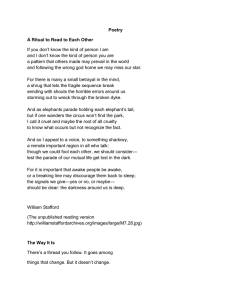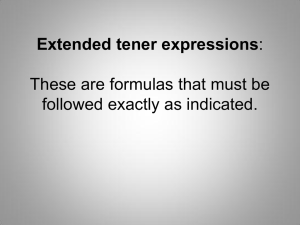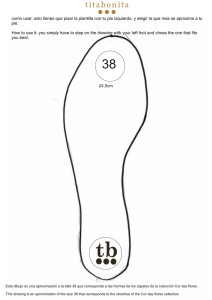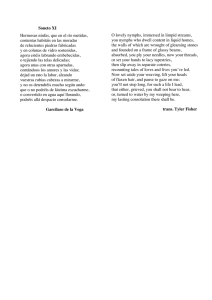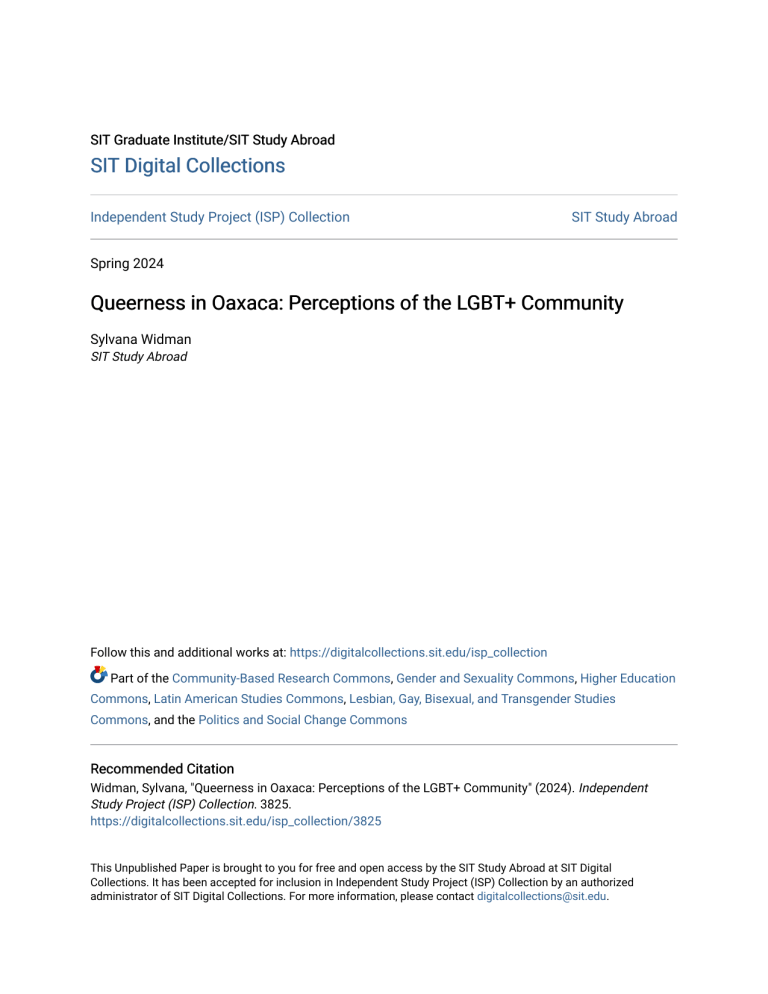
SIT Graduate Institute/SIT Study Abroad SIT Digital Collections Independent Study Project (ISP) Collection SIT Study Abroad Spring 2024 Queerness in Oaxaca: Perceptions of the LGBT+ Community Sylvana Widman SIT Study Abroad Follow this and additional works at: https://digitalcollections.sit.edu/isp_collection Part of the Community-Based Research Commons, Gender and Sexuality Commons, Higher Education Commons, Latin American Studies Commons, Lesbian, Gay, Bisexual, and Transgender Studies Commons, and the Politics and Social Change Commons Recommended Citation Widman, Sylvana, "Queerness in Oaxaca: Perceptions of the LGBT+ Community" (2024). Independent Study Project (ISP) Collection. 3825. https://digitalcollections.sit.edu/isp_collection/3825 This Unpublished Paper is brought to you for free and open access by the SIT Study Abroad at SIT Digital Collections. It has been accepted for inclusion in Independent Study Project (ISP) Collection by an authorized administrator of SIT Digital Collections. For more information, please contact [email protected]. 1 Queerness in Oaxaca: Perceptions of the LGBT+ Community Sylvana Widman School of International Training SIT Mexico: Migration, Borders, and Transnational Communities Dr. Omar Núñez Méndez May 06, 2024 2 Table of Contents Acknowledgements .................................................................................................................. 3 Abstract ..................................................................................................................................... 4 Introduction ............................................................................................................................... 5 Purpose of the Study ............................................................................................................. 6 Research Method .................................................................................................................. 6 Preliminary Findings/ Thesis ................................................................................................. 7 Literature Review .................................................................................................................. 7 Historic Attitudes and Treatment of Queerness in Oaxaca............................................... 7 Summary ....................................................................................................................... 11 Research Methodology........................................................................................................... 12 Theoretical Framework ..................................................................................................... 13 Positionality ......................................................................................................................... 13 Ethical Considerations......................................................................................................... 14 Findings and Analysis ............................................................................................................ 15 Survey Results–Levels of Acceptance ................................................................................ 20 Survey Results–Main Causes of Homophobia..................................................................... 22 Focus Group Interview ........................................................................................................ 23 Analysis............................................................................................................................... 24 Conclusion .............................................................................................................................. 26 Limitations ........................................................................................................................... 27 References .............................................................................................................................. 29 Appendix ................................................................................................................................. 30 3 Acknowledgements I would like to thank Omar Núñez for all his help and support throughout this project–his guidance helped immeasurably in keeping my research grounded and headed in the right direction. Thank you also to Paola Cruz Hernandez for her tireless work behind the scenes–from helping out with printing jobs, to negotiating with university faculty on my behalf. Thank you to the Ollín and SIT staff for teaching me so much this semester, and to all the participants in the study for donating their time and energy so that I could put this learning into practice. This topic is complex and vulnerable, and it means the world to me that my participants entrusted me with their stories. Lastly, thank you to my dear friends and classmates for their endless love and support. In such a brief period of time, they have made Oaxaca feel like a home. 4 Abstract This study examines how young Oaxacans perceive the state of LGBT+ acceptance in Oaxaca. In particular, this study surveys a general university student population, in comparison to the perceptions of a focus group of LGBT+ identifying young people. Focus group data was collected through a survey combined with a thirty-minute interview with four participants, while university data was collected through a survey distributed to 31 students at the Language School of Universidad Autónoma Benito Juárez de Oaxaca. Results from both groups found that participants’ perceived their peers as more accepting than their family or Oaxacan society at large. A significant minority believed that people who defied traditional norms of gender expression were less accepted by society, both outside and within the LGBT+ community, than those who conformed to traditional gender norms; because tradition is so key to this kind of acceptance, Muxes are generally seen as more socially acceptable than other gendernonconforming individuals. An overwhelming majority believed religion to be the primary cause of homophobia in Oaxaca, with traditional values and education as a leading second. 5 Introduction The profound impact of colonialism has long been felt in countries around the world. Spanish colonialism, in particular, drastically changed the face of Mexico’s culture and traditions. Though Mexico is now independent, the country’s culture has very much been shaped by its historic positionality in the world. Oaxaca in particular presents an interesting case of colonial impact, as the Muxe population in Zapotec communities represents a more fluid form of gender than would be accepted by the Spanish colonial mindset (Stephen 2002). Muxes, who are biologically male but take on more traditionally feminine roles, have been present in Juchitán, Oaxaca since the pre-Colombian era. Despite all being lumped together by colonizers as perverse or unnatural, Muxes, lesbian, and gay individuals all seemed to occupy different cultural spaces in contemporary Oaxacan society (Stephen 2002). As such, I found it essential to further explore modern day perceptions of LGBT+ and Muxe identities, and how these perceptions might be traced to colonial roots. Purpose of the Study LGBT+ rights have been legally codified in an increasing number of countries since 2001, with gay marriage legally recognized in 35 countries as of February 2024 (CNN, 2024). Though Mexico does not have one particular national law, more than half of Mexican states allow gay marriage, including Oaxaca (Associated Press, 2019). That being said, legal rights do not necessarily signify social acceptance. For this project, I wanted to learn more about modern Oaxacan society’s perception of LGBT+ and Muxe identities, and how the effects of colonialism might contribute to these perceptions. Thus, my research question is: What is Oaxacan society’s perceived attitude towards the LGBT+ and Muxe community, and what are some potential 6 reasons for lack of acceptance in Oaxaca? This question will help me better assess the current state of acceptance, and gain a better understanding of how connected this state might be to the historic effects of colonialism. Research Method In order to answer this question, I plan to take a combined case study and quantitative approach. This is because I want to get a broad sense of young people’s perceptions of the state of acceptance, but also want to get a more personal understanding of what queer life is like in Oaxaca. I will use my literature review to develop a broad theoretical understanding of queerness in Oaxaca, and then will distribute 31 surveys to university students. I will use these survey responses, in combination with interview responses from a queer focus group, to better inform my understanding of contemporary queerness, and how it relates to the past. Preliminary Findings/ Thesis Based on my literature review and general understanding of queerness and colonialism, I would guess that there is still a large lack of acceptance, and that colonialism still has a big impact on modern-day homophobia, because religion–Catholicism, in particular–heavily influences people’s perceptions of the LGBT+ community, and Oaxaca is heavily Catholic. I would also guess that the Muxe identity is perceived differently from the LGBT+ community, but is still heavily discriminated against. 7 Literature Review This study focuses on the LGBT+ identity as it pertains to life in Oaxaca. Important to informing my understanding of this reality is understanding the role of Muxes in Oaxacan society. In addition to this, I also explore the role of lesbians and gay men in Oaxaca. I find that academic resources on lesbianism are generally scarce, and attempt to account for this lack of institutional knowledge through a more theoretical examination of lesbianism in Oaxaca. I will examine the way this absence is addressed in complementary academic resources, and use all of this information to help form an ideological basis for my investigation. Historic Attitudes and Treatment of Queerness in Oaxaca Historically, Spanish colonialism has had a profound impact on attitudes towards queerness in Oaxaca. Colonialism upheld a more strictly defined gender system, meaning that femininity was equated with weakness, while masculinity was associated with power (Stephen, 2002). As such, gendered expectations were largely connected to homophobic perspectives. The Spaniards viewed sodomy, for instance, through gendered terms, describing the "active" and "passive" roles as the two distinct roles in a partnership. Being passive was likened to being a woman. In this way, male homosexuality was more widely viewed as an act of subversion. The state of female homosexuality at the time, on the other hand, remains enigmatic–which is to say that historic information remains obscure. It is recorded that women would hold parties and engage in sexual relationships, but Stephen’s article does not cover this aspect in much depth. It is unclear how much of this is due to a lack of information, or a lack of emphasis on the part of the author, but the author does demonstrate that lesbians and Muxes played a different role in the historic, and contemporary, imagination, than gay males. Muxes, for their part, are defined by the author as 8 individuals who appear as men, but take on female characteristics. This role, which is prevalent in the community of Juchitán de Zarragoza and often involves care taking, takes on an independent role from gendered dynamics. Muxes are a longstanding part of the Zapotec community tradition, and has been thus generally perceived more acceptably in the community than homosexual men. That being said, they may be perceived as defying traditional norms of masculinity, and are at times disparaged. The Spanish perspective had clear clash with this level of fluidity, and did not account for the nuance of the Muxe role (Stephen, 2002). While many traditions and sensibilities were preserved in Oaxacan communities, the indigenous elite also desired to maintain hierarchy, and took part in perpetuating colonial ideals (Stephen, 2002). Lesbianism in Oaxaca, as described by Bautista Garcia, found its more official political roots in Oaxaca in 1971, with Nancy Cardenas as the first public face of the movement. Lesbianism took on varied connotations for different community members: for some, lesbianism was a political identity that took umbrage with the existing state of patriarchy and heteronormativity in society, and it was a clear subversion of existing power structures. For others, the term is rejected and replaced with other terms that feel less political and are otherwise less demonized in social settings. A large part of the movement has been focused on making lesbianism more visible and securing material rights. An important part of this discourse is about “sujeto politico lesbico” (SPL), which states that being a woman is determined by one’s social relationship to a man, and the material benefits or dependencies which result from this relationship. A lesbian does not take part in these same systems, and thus is inherently politically defiant (Bautista Garcia 2022). 9 The second aspect of SPL is the collective, which has less to do with a physical collective and more to do with a history of resistance and a shared desire to modify the social perception of lesbianism and securing rights for the community. Applying these theories to lesbian lived experiences in Oaxaca, Garcia cites familial life as the first space where anti-lesbian violence is generated. In particular, the sentiment that mothers would prefer their daughters be pregnant than gay shows up in a lot of the interviews. This example is cited as a reinforcement or manifestation of the presupposition that to be maternal or otherwise a facet of the heteronormative system is to be reaffirmed as a woman. To reject this is to be nonwoman. It becomes the loss of a daughter, or even pathologized to the point of disease. Bautista Garcia cites schools as an important space to change this pattern of socialization. Dress codes are cited, as well as spaces generally dominated by men, like academia, which can thus easily become places of violence and exploitation (Bautista Garcia 2022). Both Stephen and Bautista Garcia demonstrate the systemic invisibility of lesbians in the national discourse, and Bautista Garcia is clear about the effect of gendered norms on perceptions towards lesbians. One mother tells her daughter that she would have rather heard that she were pregnant than a lesbian, highlighting just how essential heterosexuality is to one’s perception of proper womanness, and just how essential womanness is to one’s perception of personness. It would appear that these guidelines for gender expression are deeply rooted in Spanish colonial ideals. 10 Similar experiences are recounted in Oaxaca-Trans, which details alternating moments of joy, pain, and fear in the lives of trans people in Oaxaca (2024). These experiences are contrasted in McGee’s article on modern day co-optation of the LGBT+ identity, which describes the dissonance between state acceptance of LGBT+ rights and the realities of interpersonal conflicts and homophobia within Mexico and Nicaragua. The increase in legal rights and protections for the LGBT community coincided with the onset of the AIDS epidemic, as globalization increased and LGBT acceptance became a new indicator of a modern and liberal society. Despite this, the situation for the LGBT community has remained complex. Previously, LGBT activists were radical in ways that went against the state narrative. However, when the AIDS epidemic began, there was a growing need for state resources. Thus, the community and the state became more intertwined. Competition for resources meant that the LGBT movement increasingly leaned towards liberalism. As such, the LGBT+ movement has become increasingly mainstream, even as public opinion and interpersonal acceptance lags behind (McGee 2018). Writes Ramirez, the aspirations of the modern day LGBT+ movement differ somewhat from those of the Muxe community. Ramirez explains the Muxe struggle is inherently anticolonial, and would benefit more from securing material resources for survival, than from achieving acceptance within more commercial LGBT+ movements. As such, the relationship between the LGBT+ community and the Muxe people is in some ways disparate (Ramirez). 11 Summary The effects of colonialism–from Catholicism to strict gender roles–have historically had a profound impact on the culture of Oaxaca. Colonial ideals have emphasized hierarchical gender structures, thus demonizing or erasing gay and lesbian individuals. Catholicism remains a strong presence in Oaxaca, with non-Catholic ideals viewed as “foreign and anti-tradition” (O’Connor, 2016). With the rise of neoliberalism, and the subsequent rise of the AIDS epidemic, the state grew increasingly motivated to demonstrate their modernity by showing commercial support for the LGBT+ community. At the same time, the LGBT+ community grew increasingly reliant on the state for AIDS drugs, and the movement became more and more intertwined with the state. Despite this, there remains a gap between state acceptance and societal acceptance of the LGBT+ community. Muxes, for their part, have always remained an anticolonial identity, and thus inhabit a separate social and political space from the LGBT+ community. It will be an interesting experience to interview young Oaxacans, and learn more about the current perceived state of societal acceptance in Oaxaca. 12 Research Methodology In this section, I will be going over the methods I will be using for developing my research. Then I will describe my theoretical framework, followed by an explanation of my own positionality within the context of this paper, because my positionality significantly impacts the way I approach the research, and the way my research methods will be received. Lastly, I will go over ethical considerations for the project. For this research paper, I plan to gain a better understanding of the youth’s perspective on LGBT+ life in general, and a better understanding of the perspectives that LGBT+ youths have towards society. I distributed thirty-one surveys to university students, then four surveys to a focus group of LGBT+ millennials. These surveys asked participants to indicate on a scale of 1-5 how accepting they believed their peers, family members, and society to be of the LGBT+ community and Muxes. The survey then asked participants if they believed some identities to be more accepted than others, and what they believed the root causes of homophobia to be, in Oaxaca. Within the focus group, I conducted a 30 minute interview of four LGBT+ individuals from the same social circle about their experiences being LGBT+ in Oaxaca. This group was comprised of three gay men and one woman who prefers not to use labels. I began by having the group fill out the same survey distributed at the university, then had the group discuss their reactions to the survey. I then asked them about their experiences coming out to their family, if they had, and their experiences coming to terms with their queerness in Oaxaca. 13 In addition to these interviews, I also completed a literary review to supplement my knowledge of LGBT+ life in Oaxaca and Mexico, more generally. The materials I read helped to supplement and contextualize my interviews, so that I might find more basis for the interviews I collected. Theoretical Framework This paper will be principally investigating the root causes of contemporary attitudes within a society. Commonalities amongst different perspectives within one society tend to be brought about by shared understandings of how the world works. As I analyze group interviews and survey responses, I will take into account the different factors which go into these shared understandings. The contemporary culture of Oaxaca, in particular, has been affected and constructed by both pre and post-colonial cultural understandings and systems of power. As I examine contemporary attitudes and perspectives towards LGBT+ individuals, I plan to remain cognizant that I have no previous experience spending time in Oaxaca. I have learned about colonization and that Spanish social attitudes have had a profound impact upon the culture of colonized countries. That being said, I do not know the extent to which this system impacts contemporary Oaxacan society. I plan to let responses from my research subjects/ interviewees guide me. As such, for this research paper, I plan to be using a social constructivist framework. The conclusions I reach through this investigation will be very much a collaborative effort with my research subjects. Positionality Understanding the impact of my identity on my research is crucial to contextualizing my results. I approach this research topic as a white American lesbian. I was raised by liberal parents in New 14 York City, and felt comfortable enough to come out to my family when I was in high school. Though being a lesbian has profoundly impacted my life, I do not by any means believe my experience to be equivalent to that of a lesbian of any other nationality. From my personal experiences in Oaxaca, the topic does not seem to be discussed as openly as in my hometown, and in my project I want to take care to make participants feel as comfortable as possible. This leads me to the ethical considerations of the project. Ethical Considerations I don’t want to pressure any participants in my project into revealing any sensitive information about themselves that they are not comfortable with sharing. As such, I will construct my survey to be a little more open-ended when it comes to questions of personal identity, so that my participants may choose to opt out if they so choose. I will also take care to ensure that results are anonymized, and will verbally let participants know they only have to share as much information as they are comfortable with. I will make sure that the majority of my research is done through written responses, so that my participants feel less pressure to vocalize their positionality. Likewise, my focus group will consist of willing participants who I meet through my existing social circles, so that they feel as comfortable with me and familiar with the subject as possible. I will try not to hide my own personal reasons for my interest in the subject, so that participants are as familiar with my positionality as possible. Lastly, for my interviews I will distribute written consent forms to conduct voice recordings, and let participants know that I will be using pseudonyms for them. 15 Findings and Analysis Figure 1 Note. University participants were asked to rank how accepting of the LGBT+ community they perceived each community to be, with 1 being the least accepting and 5 being the most accepting. 16 Figure 2 Note. Focus group participants were asked to rank how accepting of the LGBT+ community they perceived each community to be, with 1 being the least accepting and 5 being the most accepting. 17 Figure 3 Note. Survey responses from participants who identified themselves as members of the LGBT+ community, aggregated in a single chart. 18 Figure 4 Note. University participants were asked to rank options based on what they believed to be the most likely cause of homophobia in Oaxaca, with 1 being the most likely cause and 7 being the least likely cause. 19 Figure 5 Note. Focus group participants were asked to rank options based on what they believed to be the most likely cause of homophobia in Oaxaca, with 1 being the most likely cause and 7 being the least likely cause. 20 Figure 6 Note. LGBT+ participants were asked to rank options based on what they believed to be the most likely cause of homophobia in Oaxaca, with 1 being the most likely cause and 7 being the least likely cause. Survey Results–Levels of Acceptance 21 A 5 is defined as strongly accepting. 5 or 4 is defined as accepting. 3 is neutral, and 3 and below would be considered not accepting. When it came to university responses about levels of acceptance in Oaxaca, 77.4% considered themselves accepting, with 58% marking 5 and 19.4% marking 4. 74.2% considered their peers accepting. When it came to family, 41.9% considered their family accepting, and 30 % of participants rated their family as 2 or 1. In terms of Oaxacan society’s acceptance of the LGBT+ community, 29% considered society accepting, while 71% were not accepting. On Oaxacan society’s acceptance of the Muxes, 6.7% marked 5, 33.3% marked 4, and 60% considered society to be not accepting. When it came to aggregated LGBT+ responses about levels of acceptance in Oaxaca, 77.8% considered themselves accepting. 55.9% considered their peers accepting, with 44.4% marking their peers at a 3. When it came to family, 44.4% considered their family accepting. In terms of Oaxacan society’s acceptance of the LGBT+ community, 44.5% considered society accepting, while 55.5% marked society as not accepting. On Oaxacan society’s acceptance of the Muxes, 44.4% considered society to be not accepting, with another 44.4% marking 4 for acceptance. When it came to focus group responses about levels of acceptance in Oaxaca, 100% considered themselves accepting, with 75% marking 4 and 25% marking 5. 75% considered their peers accepting, while 25% marked 3. When it came to family, 25% considered their family accepting, while 50 % of participants marked their family as a 3 and 25% marked a 2. In terms of Oaxacan 22 society’s acceptance of the LGBT+ community, 74% marked society at a 4, while 25% marked a 3. On Oaxacan society’s acceptance of the Muxes, 25% marked 4, while 75% marked a 2. Survey Results–Main Causes of Homophobia University responses for main causes of homophobia: 86.6% ranked religion as 1 or 2, with 73.3% putting religion as 1 and 13.3% putting religion as 2. Public opinion, traditional education, and traditional values all ranked as the next leading causes, at 25%, 25%, and 24%, respectively. Meanwhile, governmental policies and the media were ranked 6th or 7th by 81.8% of participants and 77.3% of participants, respectively. With 50% choosing 7th place for governmental policies and 45.5% choosing the media as 7th. Focus group responses for main causes of homophobia: 100% ranked religion as 1 or 2, with 50% putting religion as 1 and 50% putting religion as 2. Traditional education and traditional values were both ranked as 1 25% of the time, and as 2 25% and 50% of the time, respectively. Governmental policies and the media were ranked as 6 or 7 100% of the time, with 75% ranking governmental policies 7 and 25% ranking the media 7. Aggregated LGBT+ responses for main causes of homophobia: 100% ranked religion as 1 or 2, with 66.7% ranking religion 1. Public opinion, traditional education and traditional values were each ranked 1 or 2 by 22.2%, 44.4%, and 66.6%, respectively. Public opinion was ranked 1 by 11.1%, traditional education was ranked 1 by 33.3%, and traditional values was ranked 1 by 23 44.4%. Governmental policies was ranked at 6 or 7 by 100% of respondents, ranked 7 by 77.8%. The media was ranked 6 or 7 by 88.8% of participants, with half ranking 6 and half ranking 7. Focus Group Interview The interview was conducted as a group discussion with three self-identified gay men and one woman who chooses not to use specific labels. The participants were as followed, identified using pseudonyms–Juan, 28, who identifies as gay, Raul, 27, who also identifies as gay, Alejandro, 28, who also is gay, and Maria Jose, 24, who uses no labels. Juan and Raul shared similar experiences of coming out, both coming out to their mothers at young ages. Their mothers both already knew, and accepted them. Neither Alejandro nor Maria Jose are from the city of Oaxaca, and are not out to their family. The group generally seemed to agree that discrimination was more prevalent in their earlier school years, but improved in high school and university. Juan and Raul agreed that Oaxaca was generally a good place to be gay, and that they didn’t feel like they had to hide anything. Alejandro, who is from Itsmo, agrees, but took longer to come to terms with his sexuality–it is more common and accepted in Oaxaca City. The group agreed that generally, the people who are more accepted in Oaxaca are those who conform to traditional expectations of gender–gay men who are more masculine and have more money would be more accepted than those who are more feminine-presenting or have less resources. While there is more discrimination towards trans women and feminine-presenting gay people, Muxes exist in a slightly different space. Because they are part of a cultural history, the group agreed that Muxes are more accepted than a trans woman might be. Muxes are welcome in Juchitán, where they are from. Most of the group did not have much personal contact with trans people. 24 Says Raul of the attitude towards trans women, “Siempre va a estar el estigma que hay este un hombre, si dijo que ‘quiero ser Mariana’, dicen ‘es Mariano’. When comparing the state of Oaxaca to other parts of Mexico, there was slight disagreement. Juan said he thinks that in the center of the country, especially places closer to Mexico City, the LGBT+ identity is much more normal than in the south or in Oaxaca. He said he thinks we’re getting there, but in Oaxaca it is a little slower. Raul disagreed slightly, saying that although Oaxaca is not like Mexico City, he thinks people are especially open-minded in Oaxaca because there is such a sexual diversity, and that compared to other cities in Mexico, Oaxaca has advanced a lot. Oaxaca has legalized gay marriage, and was one of the first to implement sensitivity training when it comes to LGBT+ people. Analysis Because the focus group data is only compiled from the results of four participants, my analysis will primarily compare responses from the university survey, and aggregated responses from the focus group and survey respondents who identified as members of the LGBT+ community. I will analyze both the qualitative and quantitative results from these surveys and from the interviews. The quantitative results of the university survey show strong levels of self-perceived acceptance, with 77.4% of respondents considering themselves accepting–58% of which saw themselves as strongly accepting. The survey also saw high levels of perceived acceptance from university 25 peers, with 74.2% of respondents believing their peers to be accepting (Figure 1). The results of the aggregated LGBT+ responses showed a smaller majority of perceived peer acceptance, with 55.9% considered their peers accepting, and 44.4% answering the question as neutral. When it comes to acceptance from family, numbers from both the university survey and the aggregated LGBT+ surveys are consistent with one another. 41.9% of university students considered their family accepting, compared to 44.4% of aggregated LGBT+ respondents. Meanwhile, 29% of university students saw Oaxacan society as accepting of the LGBT+ identity, compared to 44.5% of aggregated LGBT+ respondents. 40% of university respondents saw Oaxacan society as accepting of Muxes, compared to 55.5% of the aggregated LGBT+ respondents. Overall, the surveys from LGBT+ respondents perceived peers as slightly less accepting than their university counterparts, but saw Oaxacan society as slightly more accepting towards the LGBT+ community and Muxes. When it came to the main causes of homophobia in Oaxaca, both groups overwhelmingly selected religion as the primary reason, with 86.6% of university students picking religion as their first or second choice, and 100% of aggregated LGBT+ responses selecting religion as their first or second choice. Similarly, both groups selected public opinion, traditional education, and traditional values as the runners-up of leading causes, with traditional education and values leading over public opinion. Both groups ranked governmental policies and the media as the least relevant causes of homophobia. In terms of qualitative results, surveys from university students had significant similarities to the responses from the focus group. The focus group generally agreed that individuals who conformed to traditional gender expression were more accepted than those who did not. 26 Similarly, 13 out of 31 (42%) university respondents indicated that trans people were less accepted than their queer peers. Discrimination against people who don’t dress according to traditional gender norms is frequently mentioned on the surveys. Conclusion The primary objective of this investigation was to examine young Oaxacans’ contemporary perceptions of the LGBT+ community and Muxes in Oaxaca, and figure out potential contributing factors towards these attitudes, including the effects of colonialism on current day attitudes. The investigation was conducted using a social constructivist framework, and thus utilized a more open-ended research question and investigation process. The investigation combined a quantitative and qualitative approach by distributing surveys to both a general university population and a focus group of LGBT+ identifying young people. This investigation showed that both university students and LGBT+ identifying participants perceive their peers as being more accepting of the LGBT+ identity than their families/ older generations and Oaxacan society. Acceptance seems very much linked with gender expression, as both research groups agreed that queer individuals who conformed to traditional gender expression–masculine gay men and feminine lesbians–were more accepted than those who defied it. The overwhelming reason for this lack of acceptance seems to be due to religion and tradition, traits which one survey participant noted are very much intertwined. Based on discussions with the focus group, this seems to be part of the reason why Muxes might be more accepted than trans women–one group is part of tradition, while the other seemingly defies it. 27 While quantitative results suggested that there is a ways to go before universal LGBT+ acceptance, interviews with the focus group offer a counterpoint. Progress in Oaxaca moves slowly, but the LGBT+ community is certainly visible, and growing in support and visibility by the day. As Raul puts it, “Es bueno vivir en oaxaca. Nunca he escondido nada.” The results of this investigation more or less confirm the ideological basis of the papers in my literature review, and help provide a pulse check of LGBT+ life in Oaxaca. In particular, this research does in some ways affirm McGee’s description of modern dissonance between political rights and social acceptance. There was widespread agreement in the surveys that the government and the media were not prevalent reasons for homophobia in Oaxaca. Instead, the main reasons lie in religion and tradition–both of which were constructed and enforced particularly during the period of Spanish colonization. Indeed, the connection between gender expression and acceptance, mentioned in both Stephen’s and Bautista Garcia’s papers, was heavily affirmed in both the focus group interviews and in the university surveys. Limitations This research did face significant limitations, in part because of the sensitivity of the topic and in part because of the accessibility of interviewees. The university survey was distributed in the language school of the university–some of these distributions were random, while the rest were distributed to a braille class. This could pose a potential bias in the results, as the class focused a lot on contemporary issues of accessibility and discrimination, and the student population might skew more progressive. Likewise, the focus group was all members of the same social circle, and might be like-minded when it comes to the topic. The focus group was also comprised of three gay men and one queer women, and most of the conversation was between the three gay men. As 28 such, I got a lot of data from the perspective of cis gay men, but not as much from gay women or trans people. Despite all these factors, I believe the sample size at the university was large enough and random enough to mitigate these biases. The focus group came from one particular walk of life, but members of the group acknowledged that much of their perspective was based in their positionalities as masculine queer men, and referenced the experiences of their other queer friends. Looking to the future, this research would benefit from further investigation into the perspectives of lesbian women and trans people. I hoped to learn more about the lesbian perpective, as Bautista Garcia’s paper emphasized the invisibility and erasure of lesbian perspectives in Oaxaca, but it was difficult to find willing lesbian participants. My focus group participant also seemed concerned about giving out personal information, and I wanted to prioritize her comfort and security. Future investigations would do well to investigate specifically the perception of lesbians and trans people. This will help provide a more comprehensive look at social attitudes towards the entire LGBT+ community in Oaxaca. 29 References 1. Sexualities and genders in Zapotec oaxaca - Lynn Stephen, 2002. (n.d.-b). https://journals.sagepub.com/doi/10.1177/0094582X0202900203 2. Choi, A., & Razo, J. (2024, February 16). Where same-sex marriage is legal around the world. CNN. https://edition.cnn.com/world/same-sex-marriage-legal-countries-mapdg/index.html 3. AP News. (2023, December 16). Lawmakers OK same-sex marriage in Mexico’s Oaxaca State. AP News. https://apnews.com/general-news-b745a27c8f9b49bba3ff0c9fb6596d0a 4. Bautista Garcia, V. (2022). Nombrarme Publicamente Y Habitar Mi Ser Lesbiana: Trayectorias De Configuracion Identitaria Y Construccion Como Sujeto Politico Lesbico En Oaxaca. CIESAS Repository. https://ciesas.repositorioinstitucional.mx/jspui/handle/1015/1516 5. Oaxaca-trans: Historias de Vida. Traficantes de Sueños. (2024, April 29). https://traficantes.net/libros/oaxaca-trans 6. McGee, M. J., & Kampwirth, K. (2018, January 2). The co-optation of LGBT movements in Mexico and Nicaragua: Modernizing clientelism?: Latin American politics and Society. Cambridge Core. 30 7. Hybrid gender colonization: The case of muxes - Ramirez. (n.d.). https://onlinelibrary.wiley.com/doi/full/10.1111/gwao.12884 8. O’Connor, M. I. (2016). Mixtecs and Modernity. In Mixtec Evangelicals: Globalization, Migration, and Religious Change in a Oaxacan Indigenous Group (pp. 27–42). University Press of Colorado. http://www.jstor.org/stable/j.ctt1gpcbxk.9 31 Appendix Here I list the questions used to guide my interviews. 1. Por favor, indica tu edad y cómo describirías tu orientación sexual. 2. ¿Tuvieron alguna reacción inicial a la encuesta? 3. ¿Puedes contarme un poco sobre cómo llegaron a darse cuenta de que eras gay? 4. ¿Has salido del clóset con tu familia? ¿Cómo fue la reacción de tu familia? 5. ¿Cómo describirían las actitudes de las personas en su comunidad hacia la comunidad LGBT? ¿Hay diferencia en las actitudes entre personas de diferentes generaciones/ otros grupos? 6. ¿Cómo compararían la experiencia de vivir en Oaxaca para una persona con sus identidades versus otras identidades dentro de la comunidad LGBT? 32 Below is the survey used to gather university and focus group responses. GRACIAS POR DARME 5 MINUTOS DE TU TIEMPO PARA COMPLETAR ESTA ENCUESTA. EL PROPOSITO ES ENTENDER MEJOR LAS ACTITUDES DE LA POBLACION JOVEN HACIA MIEMBROS DE LA COMUNIDAD LGBTQ EN OAXACA. LA ENCUESTA ES ANONIMA Y LOS RESULTADOS SERVIRAN PARA COMPLETAR UN TRABAJO INDEPENDIENTE DE INVESTIGACION. Instrucciones: Utilizando la escala del 1 al 5, siendo 5 el más aceptado y 1 el menos aceptado, favor de responder las siguientes preguntas: 1. ¿Qué tan aceptable piensas que tu eres hacia las personas que se identifican como parte de la comunidad LGBT+? 1 2 3 4 5 1. ¿Qué tan aceptable piensas que son tus compañeros universitarios hacia las personas que se identifican como parte de la comunidad LGBT+? 1 2 3 4 5 1. ¿Qué tan aceptable piensas que es tu familia hacia las personas que se identifican como parte de la comunidad LGBT+? 1 2 3 4 5 1. ¿Qué tan aceptables piensas que son los oaxaqueños hacia las personas que se identifican como parte de la comunidad LGBT+? 1 2 3 4 5 1. ¿Qué tan aceptable piensas que son los oaxaqueños hacia quienes se identifican como Muxes? 1 2 3 4 5 1. Si desea elaborar sobre alguna de estas respuestas o añadir algo, por favor hazlo a continuación: 33 1. ¿Piensas que existen personas de la comunidad LGBT que son más aceptad@s que otr@s? Si es así, ¿cuáles? Por ejemplo, ¿alguien trans es mejor aceptado que alguien gay? 1. ¿Cuáles piensas que son las principales razones por las cuales las personas no aceptan o ven de manera negativa a quienes se identifican como miembr@s de la comunidad LGTBQ? Marca con el número 1 de la lista abajo la razón que crees es la más fuerte para este rechazo, de ahí el número 2, 3, 4…dependiendo de tu percepción: 1 la más importante y 7 la menos relevante o de menor impacto La religión ( ) La opinión pública ( ) La presión de grupo ( ) La educación tradicional ( ) Políticas Gubernamentales ( ) Medios de Comunicación ( ) Los valores tradicionales/locales ( ) ¿Otra razón que consideres importante mencionar?: ____________________________________ Si desea elaborar sobre alguna de estas respuestas, o añadir algo, por favor hazlo a continuación: 8. ¿Te identificas como parte de la comunidad LGBT? a) si b) no c) prefiero no compartirlo d) otra respuesta: _____________________________________ 1. Si tu respuesta fue afirmativa, ¿cómo te identificas específicamente dentro de la comunidad LGBTQ? ¡Gracias por tu tiempo! ¿Te interesaría continuar participando en este estudio por medio de una entrevista de 30 minutos? Si te interesa, favor de proporcionar tu correo electrónico y tu primer nombre para contactarte. Tu privacidad y anonimidad en esta entrevista será garantizada y los resultados de mi investigación no proporcionaría ningún dato que pueda llevar a identificar a los participantes. 34 Below are the tables used to collect survey results for university students and the focus group. Table–University Survey Results Re Pregunta 6 sp (si quieres elaborar sobre ues alguna de estas respuestas) ta nu me ro 7 (piensas que existen personas de la comunidad Identificas LGBT que son mas acepta@s que otr@s? Si es como parte de asi, cuales? la comunidad LGBT? 1 - Si, los homosexuales No 2 - No No 3 - Ya que a muchas personas no les agrada las personas que se viisten con el genero opuesto, pero considero que una persona gay es mas aceptado. No 4 - No, porque al ser trans sufren mas discriminacion Prefiero no compartirlo 5 - No, pienso que aun hay mucha homofobia hacia toda la comunidad No 6 - Si, considero que las personas con diferentes orientaciones sexuales son mas aceptadas que aquellos que no se identifican con su sexo de nacimiento No 7 - Los gays son mas aceptados que las personas lesbianas No 8 - Si, ya que en su totalidad ya es hombre o mujer y un gay no No 9 - Si, creo que entre mas cumplan con la normativa son mas aceptados que las personas trans pq no alteran su apariencia Si, lesbiana 10 - Pienso que es mas aceptado el ser gay. En la No 35 sociedad no es bien visto el cambio u operacion fisica para cambiar de genero o ser trans. 11 No se modela a las personas LGBT+, pero aun es raro y mas en zonas rurales Si, las que son mas discretas con sus preferencias No 12 - No se especificamente No 13 - Siento que las chicas que son lesbianas son mas aceptadas que los chicos gays No 14 - Si, creo que las personas gay son mejor aceptadas que las personas trans No 15 - Si, por lo general las personas gay, lesbianas y bisexuales, son un poco mas aceptadas No 16 - - No 17 - Yo pienso que las personas homosexuales son Si, bisexual mas aceptadas que las trans porque les cuesta un poco menos entenderlas en comparacion con alguien que sea trans 18 - Considero que alguien gay es mas aceptado que una persona trans No 19 - Pienso que los gay ya en hubo un tiempo en donde se puso de “moda” No 20 - Todos son aceptables menos a los que no respetan su origen normal y su punto de visita No 21 - - Si, bisexual 22 - Considero que no, ya que aqui en oaxaca tienden a marcar el genero, por lo que si alguien se cambia el genero lo juzgan por no ser tan comun Prefiero no compartirlo (No se como me identifico aun) 23 - - Sin etiqueta (Se que no soy completament e hetero, pero no se que soy.) 36 24 Quiza las personas adultas mayores son menos tolerantes a la comunidad LGBT, porque la gran mayoría de los jovenes si somos muy inclusivos con la comunidad Las personas trans son menos aceptadas porque aun existen mentalidades cerradas Prefiero no compartirlo 25 - Las personas blancas, heteronormativas Si, trans 26 Considero que la preferencia sexual es de cada persona y no le deberia incombir a los demas ni ser de significancia para los organamos gubernamentales Si hay personas mas aceptadas que otras. Considero que un gay es mas aceptadoo que un trans no 27 Pienso que en el caso de Oaxaca aun falto mucho que concientizar acerca del respeto hacia personas con otras preferencias o identificaciones de genero Siento que en caso de los gays es un poco mas aceptado y normalizado Prefiero no compartirlo 28 - No porque son el mismo sexo No 29 - Todas son aceptadas en los grupos sociales, por lo que veo en cada grupo de amigos hay un integrante LGBT No 30 - - No 31 - - No La religion todavia juega un papel importante para la estigmatizacion de este tema Table–Focus Group Responses Resp Pregunta 6 uesta (si quieres elaborar sobre nume alguna de estas respuestas) ro 7 (piensas que existen personas de la comunidad LGBT que son mas acepta@s que otr@s? Si es asi, cuales? Identificas como parte de la comunidad LGBT? 1 Si, considero que algunas personas son mas Si, Gay Considero que a veces el ser 37 2 Muxe es a toma doberla con algunas personas heterosexuales aceptadas que otras, interfiero mucho a que sean discretas o alguna situación serológica (homosexual) Creo que depende conquee personas te relaciones No, creo que no siempre sucede en especial con trans, considero que son más juzgados en muchos casos Prefiero no compartirlo Considero que la religion y los valores tradicionales locales, son 2 aspectos importantes porque van de la mano 3 4 Son mas aceptados los gays masculinos, las lesbianas femininas. Pienso que queces hay Las personas gay con actitudes femininas o discriminacion entre la misma que no son hegemonicas son menos aceptados comunidad lgbt igual que las mujeres trans Si, gay Si, gay

